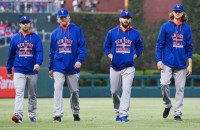Can’t Hit What You Can’t See

The general consensus as to why Hall of Famer Walter Johnson was so dominant was the saying, “You can’t hit what you can’t see.” In analyzing MLB’s Statcast data, that saying could now be applied to the young New York Mets pitching staff.
As the article notes, the Mets threw more pitches than any other team over 95 MPH. Nearly a thousand more. The main reason for this was the trio of Matt Harvey, Jacob deGrom, and Noah Syndergaard. Harvey’s two-seamer averaged 95.4, and his four seamer averaged 95.3. deGrom’s two seamer averaged 95.6, and his four seamer averaged 96.0. As all Mets fans know, Syndergaard led the pack. His two seamer averaged 98.3, and his four seamer averaged 98.4. Amongst starting pitchers Symdergaard threw the fastest.
This trio of hard throwing righties kept the Mets afloat in 2015 while the offense spluttered. When the team then assembled a major league capable offense, these pitchers led the Mets to the World Series. In 2016, it’s only going to get better.
Last year, the Mets had innings limits, skipped starts, and at times, six man rotations. Syndergaard wasn’t called up until May. In 2016, the Mets have said innings limits and the like will not be an issue. As such, all three of the Mets aces should be expected to make 32 starts and throw over 200 innings. This means more 95+ MPH fastballs. Again, batters will have trouble hitting the pitches they can’t see.
If that wasn’t enough, it gets even better. Steven Matz should start the year in the rotation. According to Brooks Baseball, Matz’s fastball averaged 94.57 MPH. Prior to Matz’s lat injury, his fastball averaged 94.90 MPH. With a full season of a healthy Matz, the Mets will further increase the amount of fastballs throw over 95 MPH.
In addition to a full season of Matz, the Mets can expect a half a season of Zack Wheeler. In Wheeler’s career, his four seamer averaged 95.87 MPH, and his sinker averaged 95.50 MPH. All told, upon Wheeler’s return, the Mets will feature a starting rotation that has five pitchers bringing the heat at over 95 MPH. That is just incredible.
However, why does it matter? Well, as FiveThirtyEight showed last year, it is just harder to hit a fastball that’s thrown 95 MPH and above. In total, batters swung and missed at pitches thrown this fast 22.8% of the time. That’s about 5-10% more frequent than pitches thrown slower.
More importantly, as we saw in last year’s NLCS, the Cubs are more likely to swing and miss at these pitches than any other team in baseball. Heading into the 2016 season, it appears that yet again it will be the Cubs standing in the Mets way. The pitching staff the Mets have constructed is not only effective against the Cubs, but also every single team in baseball.
The Mets 2016 pitching staff is the single best argument why any team in baseball will go to and win the World Series. The Mets young starters brought the heat last year. Next year will be more of the same.
Good luck to the National League next year because you can’t hit what you can’t see.
Editor’s Note: this article first appeared on metsmerizedonline.com